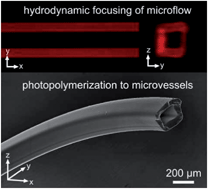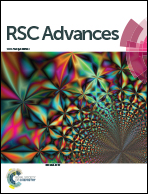Microfluidic fabrication of multiaxial microvessels via hydrodynamic shaping†
Abstract
A microfluidic fiber fabrication device was developed to prepare multiaxial microvessels with defined architecture and material constituency. Hydrodynamic focusing using passive wall structures directed biologically relevant macromer solutions into coaxial flow patterns, which were subsequently solidified via photopolymerization. Solid, coaxial, and triaxial microfibers as well as microtubes were generated from the multiaxial flows composed of both synthetic macromers and biomacromolecules.


 Please wait while we load your content...
Please wait while we load your content...